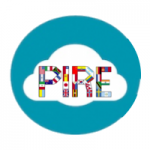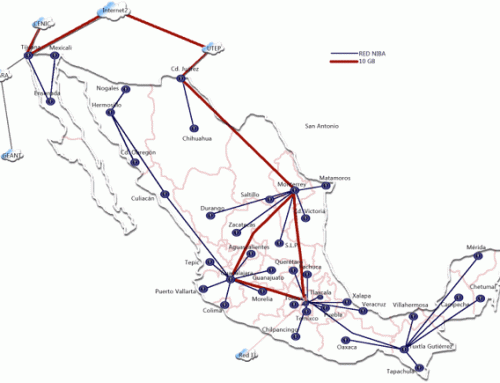Newsletter September 2013
1. Major Network Upgrade between Brazil and United States Enables International Collaboration and Innovation
2. South American Astronomy Coordination Committee Convenes in August 2013
3. US National Science Foundation Announces Launch of UofC Bionimbus Protected Data Cloud to Analyze Cancer Data
4. Open Science Data Cloud Automates Provisioning
5. NSF International Research Network Connections (IRNC): Usage and Value Measurements
6. A Digital Highway to ALMA
7. CENIC’s Louis Fox Receives the Richard Rose Award from Internet2
8. CLARA Publication: RedCLARA: Nombre, voz e instrumento de la collaboration en America Latina
9. Quick Links
Major Network Upgrade between Brazil and United States
Major Network Upgrade between Brazil and United States Enables International Collaboration and Innovation
AmLight 40 Gigabit Upgrade Made Possible by Brazil and U.S. Research & Education Networks ANSP, RNP and Florida International University
Florida International University announced today that a three-year project upgraded the interconnectivity between the AMPATH International Exchange Point in Miami and the SouthernLight Exchange point in São Paulo, therefore doubling the network capacity between Latin America and the U.S. from twenty gigabits per second (Gb/s) to forty Gb/s.This upgrade established a ring topology using four diverse ten Gb/s connections by moving data in both a clockwise and counterclockwise direction around a ring, providing redundancy in case of a fiber cut on one portion of the network links.
Read More…
Two of the four diverse ten Gb/s systems head east, with one stopping at Brazil’s National Research and Education Network (RNP) exchange point in Rio de Janeiro, Brazil, continuing towards the new CearaLight Exchange point in Fortaleza, BR then on to Miami, Fla. The remaining two diverse 10 Gb/s systems are point west, with one stopping in Santiago, Chile then towards Miami via Panama.
“Academic Network of São Paulo (ANSP) provides connectivity to more than fifty institutions, which are responsible for more than forty percent of Brazilian science production. The present duplication of the international links is a natural continuation of our partnership with RNP and FIU established in 2004 and has been enhanced in one way or another every year since,” said Dr Luis Lopez, Principal Investigator (PI) of ANSP. “Now, with a nominal connectivity of 40 G (and an expected minimum of no less than 30 G), our research community is able to increase even more their collaborations with other institutions, both in Brazil and abroad.”
With this enhanced connectivity throughout the Americas and beyond, global collaboration has reached a new level, especially regarding data-intensive sciences. As the pace of innovation in these sciences has accelerated, advanced networking has become increasingly vital.
See the complete press release here
SAACC Convenes in August 2013
Read More…
The SAACC Charge: “Given the extensive use of AmLight by the astronomical community, the AmLight PI will convene a South American Astronomy Coordination Committee (SAACC) that will be comprised of representatives from the various astronomy projects who are conducting projects or operating observatories in South America. … The SAACC will serve not only to provide input and advice to the AmLight PI and the Steering Committee on program and network needs, but will also serve as a venue for coordinating the needs of these astronomical projects and institutions to improve their resource planning and implementation of operational connections between these distant facilities and users in the continental US.”
For meeting slides and links to further SAACC information click here.
AmLight Stakeholder Survey – 5 Minutes, 5 Bucks
Please take 5 minutes to complete a brief survey. Your response is greatly appreciated and you will receive $5 Amazon Gift Card. In addition to that, 5 participants will be randomly selected for $50 Amazon Gift Cards after the survey is closed on 09/30/2013. The survey was designed to gather information about your experience with the AmLight project. Your response will provide data to improve the project.
https://fiu.qualtrics.com/SE/?SID=SV_bCpXALYkRUOYEZL
Bionimbus Protected Data Cloud to Analyze Cancer Data
US National Science Foundation Announces Launch of UofC Bionimbus Protected Data Cloud to Analyze Cancer Data
Medical advances facilitated by NSF-funded foundational research provide alternative to large, costly and cumbersome storage infrastructure
The University of Chicago launched the first secure cloud-based computing system that enables researchers to access and analyze human genomic cancer information without the costly and cumbersome infrastructure normally needed to download and store massive amounts of data.
Read More…
The Bionimbus Protected Data Cloud, as it is called, enables researchers who are authorized by the National Institutes of Health (NIH) to access and analyze data in The Cancer Genome Atlas (TCGA) without having to set up secure, compliant computing environments capable of managing and analyzing terabytes of data, download the data–which can take weeks–and then install the appropriate tools needed to perform the desired analyses.
Using technology that was developed in part by the Open Science Data Cloud, a National Science Foundation-supported project that is developing cloud infrastructure for large scientific datasets, the Bionimbus Protected Data Cloud provides researchers with a more cost- and time-effective mechanism to extract knowledge from massive amounts of data. Drawing insights from big data is imperative for addressing some of today’s most vexing environmental, health and safety challenges.
For more information, visit http://1.usa.gov/143rg1Y
To see a demo led by Allison Heath of the Laboratory of Advanced Computer on how to run a query on the Protected Data Cloud,visit http://www.youtube.com/watch?v=v9hW1g2WpYQ
Open Science Data Cloud Automates Provisioning
 Amlight’s Julio Ibarra presented a paper on the Open Source Data Cloud at the Trans-European Research and Education Networking Association’s 2013 conference. OSDC (Open Source Data Cloud) provides tools so that researchers can upload and analyze datasets, integrate their data with data from research collaborators, and integrate their data with public data for analysis. The OSDC currently hosts more than 600 TB of public datasets from a number of disciplines, published online and available to users.
Amlight’s Julio Ibarra presented a paper on the Open Source Data Cloud at the Trans-European Research and Education Networking Association’s 2013 conference. OSDC (Open Source Data Cloud) provides tools so that researchers can upload and analyze datasets, integrate their data with data from research collaborators, and integrate their data with public data for analysis. The OSDC currently hosts more than 600 TB of public datasets from a number of disciplines, published online and available to users.
Read More…
Members include universities, (University of Chicago, Florida International University, University of Illinois Chicago, Northwestern University), companies, (Cisco and Yahoo), government agencies (NSF, NASA) and foreign partners (University of Edinburgh, UNESP, UFF, BIG, University of Amsterdam, AIST, etc.).
For more information and a downloadable slide set, visit http://bit.ly/1b1eker
Usage and Value Measurements
The NSF’s International Research Networks Connections (IRNC) Program supports the research and education community by funding globally interoperable high-bandwidth infrastructure, coordinated experimental services, and human network community building. At the January 2013 IRNC principal investigator (PI) meeting, one area of discussion was measurement capabilities and opportunities that could provide NSF and others with greater insight into what science projects are supported internationally through this program. This note summarizes discussions at the meeting, including each project’s current measurement activities, and consensus on several concrete directions that would support greater visibility into IRNC infrastructure operations, usage, and value.
Read More…
To download a PDF copy of the paper, visit http://bit.ly/14tknVj
As a recipient of one of the NSF-funded IRNC Special Projects (“Sustainable data-handling and analysis methodologies for the IRNC networks”, NSF Award 0963073), the Cooperative Association for Internet Data Analysis (CAIDA) at the University of California San Diego created a wiki for the various IRNC collaborators to use. The intent of the wiki is to provide an easily updateable collection of resources and information about IRNC measurement and data collection efforts. To visit the IRNC Wiki, visit http://bit.ly/11j9nsF.
A Digital Highway to ALMA
This new digital highway, which will be operational in 2014, will not only handle the transfer of the enormous quantities of data that ALMA will produce when fully built, but it will also allow for better communication between those operating the observatory from the remote and hostile location in the Atacama Desert, and those processing the data at the ALMA offices in Santiago, as well as the scientific community throughout the world. An updated progress report will be shared at the next South American Astronomy Coordination Committee (SAACC) meeting. For more information, visit http://bit.ly/PTHxlH New network infrastructure that will allow the ALMA (Atacama Large Millimeter/submillimeter Array) observatory to increase its data transmission capacity by more than 25 times has begun construction.
New network infrastructure that will allow the ALMA (Atacama Large Millimeter/submillimeter Array) observatory to increase its data transmission capacity by more than 25 times has begun construction.
The new system involves the installation of about 150 kilometres of fibre optic cable between the observatory (34 kilometres from San Pedro de Atacama) and the town of Calama. From there data will flow via existing communication links to the academic network REUNA in Antofagasta. The link from there to the ALMA offices in Santiago will use infrastructure created in 2010 by EVALSO, a project co-funded by the European Commission and operated by REUNA that already provides connectivity for ESO’s observatory at Paranal, among others (see eso1043 for more about EVALSO). The fibre project is managed by Giorgio Filippi, from ESO, who is seconded to the Joint ALMA Observatory.Read More…
CENIC’s Louis Fox Receives the Richard Rose Award from Internet2
Louis Fox, president and chief executive officer at CENIC, has been honored with this year’s Richard Rose Award, which recognizes extraordinary individual contributions to extending advanced networking to the broader education community.
“Louis has committed his career to ensuring all learning communities, particularly those in underserved and isolated areas, benefit equally from access to advanced broadband enabled technology,” said H. David Lambert, Internet2 president and chief executive officer. “His work clearly illustrates how the value of research and education networks increase the more broadly inclusive they become.”
For more information, see original article here.
CLARA Publication
The new CLARA publication, CLARA: Name, Voice and Collaboration tool in Latin America in December 2008 – January 2013 is available for download at the Clara website. To get your copy, visit http://bit.ly/17Y3b1v
Quick Links
* A nice tutorial on Data Warehousing from the GigaOm folks http:// bit.ly/1b1eker
* A magnet is slowly lowered underground to be taken to the # LHC tunnel @ CERN . Working for the # LS1 upgrade plans.pic.twitter.com/NdZkrR1BtS
* After a yr of upgrades, we’re almost ready to get Fermilab’s accelerator complex switched on again http://www. fnal.gov / pub / today / arch ive/archive_2013/today13-06-04.html …
* EU-US Nets get # 100Gbps Atlantic
* ALMA has Announced the signature of the Contracts for the OSF-Antofagasta path optical infrastructure. The … http:// fb.me/1FKM9JPxo
